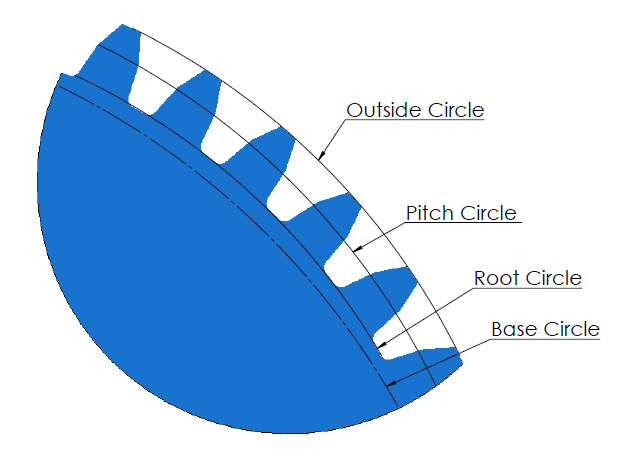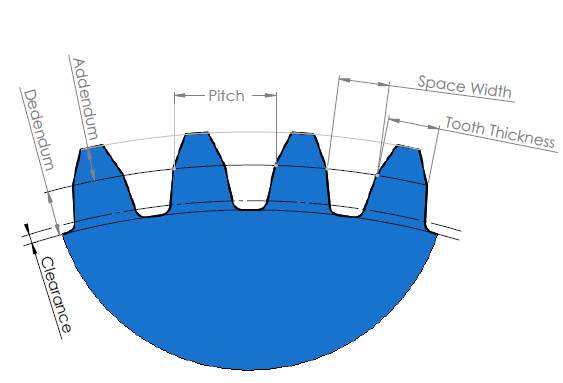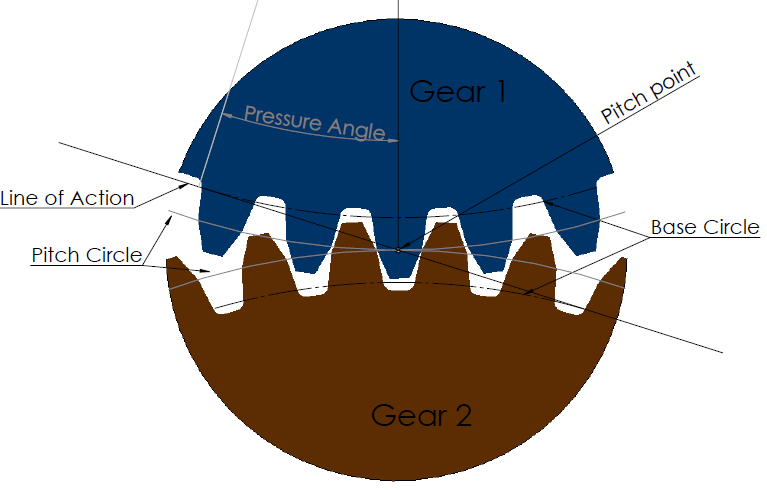A Gear application is to transfer power from one shaft to another shaft at the same or different speeds. This article covers gear terminology or basic terms used in gears and gear calculations. We suggest you also read this article on types of gears and their applications.
Gear Terminology
Engineers use the following basic gear terminology while working on gears.
- Face Width
- Base Circle
- Dedendum Circle / Root Diameter
- Addendum Circle / Outside diameter
- Pitch Point
- Pitch Circle
- Pitch Circle Diameter
- Pitch Surface
- Diameter Pitch
- Addendum
- Dedendum
- Diametral Pitch
- Circular Pitch
- Module
- Tooth Thickness
- Tooth Space
- Tooth Face
- Flank of tooth
- Top Land
- Pressure Angle
- Total Depth
- Working Depth
- Clearance
- Backlash
Gear Face Width
It is the length of the gear teeth in the axial direction.
Base Circle
It is the circle from where generate the involute teeth profile.
Dedendum / Root Diameter
Root Diameter is the gear diameter at the root circle or bottom teeth.

Pitch Circle
It is the imaginary circle on a gear where mating gears meet with each other.
Pitch Circle Diameter
The diameter of the pitch circle is known as pitch circle diameter.
Addendum / Outside Diameter
It is the diameter of gear at the top tip of gear teeth.
Addendum
It is the height of gear teeth above the pitch circle.
Dedendum
The height of gear teeth below the pitch circle is known as Dedendum.
Diametral Pitch (p)
The diametral pitch of the gear is the number of teeth per inch of pitch circle diameter. It defines the spacing of teeth along the pitch circle.
Diametrical Pitch (p) = number of teeth / pitch circle diameter

Circular Pitch
A circular pitch is a distance between two gear teeth at the pitch circle.
Module of a Gear
The module of gear is inverse of the diametric pitch. Mathematically it is equal to the ratio of pitch circle diameter and number of teeth. Gears with the equal module can only mate with each other.
Module (m) = Pitch circle diameter / Number of teeth
Tooth Thickness
It is the width of the tooth at pitch circle diameter.
Tooth Space
It is the distance between two adjacent teeth at the pitch circle.
Tooth Face
It is the surface of the tooth above the pitch surface.
Flank of Tooth
It is the surface of the tooth below the pitch surface.
Top Land
The top tooth surface is known as gear top land.
Pitch Point
In a mating gear, the pitch point is a point of contact between two pitch circles.
Pressure Angle of a Gear
Pressure angle is the angle between the gear center line and a line perpendicular to the line of action. It defines the tooth profile. Generally, pressure angle value is kept at 20°, 25°, 22.5°or 14.5°.

Higher pressure angle increases gear strength and reduces tooth tip interference. But they cause higher noise and bearing load.
Clearance
Mathematically clearance is equal to the difference between the dedendum of one gear and the addendum of the mating gear.
Clearance in Gears = Dedendum of Gear2 – Addendum of Gear1
Backlash between Gears
It is the tangential space between gear mating teeth at pitch circles.
Backlash in Gears = Teeth Space – Teeth Width
We will keep updating more information on various Gear Terminology: Basics of Gears. Add your comments or questions to Gear Terminology in the comment box. Click this link if you want to know more about Reduction gear drives.

Add a Comment